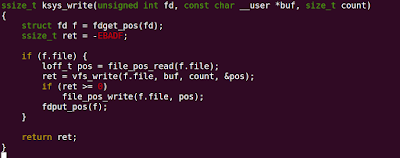Internal flow of what happens when you call write in userspace on a device file in Kernel
Let's see what happens when a user-space application calls write on a device file, for example in our previous program we wrote our own null device: /dev/my_null
So, we execute write using: echo "Hello" > /dev/my_nul
Userspace internally calls GLibC write call which calls write System Call.
Step1: Write system call in kernel is executed which is present in fs/read_write.c, which calls ksys_write
Step2: The fd passed by user is an index in the file descriptor table present in the kernel, fdget_pos fetches the struct fd of the particular file
struct fd {
struct file *file;
unsigned int flags;
};
Step 3: In vfs_write,
So, we execute write using: echo "Hello" > /dev/my_nul
Userspace internally calls GLibC write call which calls write System Call.
Step1: Write system call in kernel is executed which is present in fs/read_write.c, which calls ksys_write
Step2: The fd passed by user is an index in the file descriptor table present in the kernel, fdget_pos fetches the struct fd of the particular file
struct fd {
struct file *file;
unsigned int flags;
};
static inline loff_t file_pos_read(struct file *file)
{
return file->f_pos;
}
This position extracts the offset within the file, and calls vfs_write, and then the return value of write call is updated with offset
Step 3: In vfs_write,
- It checks whether the file was opened in read-only mode
- Checks whether this file has write method
- Whether the passed user buffer is a valid buffer for reading
- Verifies the area for writing is valid and for security permissions
- And calls __vfs_write
Step 4: Finally in __vfs_write, it calls our write function present in the fops (struct file_operations) present in the struct file.
So, this is the way, even if we pass only three arguments from user space, kernel reads the offset from the file and pass it to our write function defined in our driver.







Comments
Post a Comment